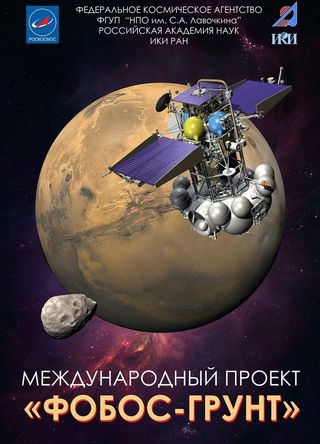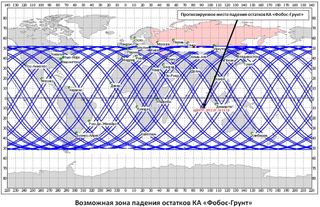
Russian Mars Probe to Crash Soon, With World Watching

A coordinated global campaign is monitoring a wayward Russian Mars probe that's slated to crash to Earth in the next few days, the European Space Agency has announced.

The doomed Phobos-Grunt spacecraft, which Russian officials estimate will re-enter Earth's atmosphere between Saturday and Monday (Jan. 14-16), is now officially a target for the 12-member Inter-Agency Space Debris Coordination Committee, or IADC for short.
"An IADC re-entry prediction campaign is ongoing since January 2. Phobos-Grunt was identified to be no high-risk object," said Heiner Klinkrad, head of the space debris office at the European Space Agency's (ESA) European Space Operations Centerin Darmstadt, Germany. "Hence, this will be adopted as our annual 'test campaign' for 2012," he told SPACE.com.
The determination that Phobos-Grunt is not a high-risk piece of space junk is due to the relatively low dry mass of the errant spacecraft — just 2.5 tons. There is about 11 tons of toxic propellant onboard, adding up to the probe’s total mass of 13.5 tons.
According to ESA, studies by the Russian space agency (known as Roscosmos) and NASA indicate that Phobos-Grunt's fuel tanks should burst high above the Earth, releasing a load of propellant that will subsequently dissipate. [Photos of the Phobos-Grunt mission]
"Because it was stuck in low Earth orbit rather than heading towards Mars, this has meant that it's full of fuel too," said Alice Gorman, a lecturer in the School of Humanities, Department of Archaeology at Flinders University in South Australia.
Gorman specializes in space archaeology and noted that the fuel tanks, according to the Russian space agency, are made of aluminum.
Get the Space.com Newsletter
Breaking space news, the latest updates on rocket launches, skywatching events and more!
"More than 50 percent of all re-entered spacecraft material is titanium, beryllium or steel, which has a melting point twice that of aluminum, so the likelihood of the fuel tanks surviving is very low,” Gorman said. "The fuel is reported to be hydrazine and nitrogen tetroxide, which boil at 113 degrees Celsius and 21 degrees C (235 F to 69 F) respectively, so it will evaporate at high altitude once the tanks go."
Phobos-Grunt leftovers
Roscosmos has said that, at most, 20 to 30 fragments of Phobos-Grunt, weighing a total of less than 440 pounds (200 kilograms), may reach Earth’s surface. However, given that most of our planet's surface is covered by water, the probability that these pieces will fall onto populated terrain is seen as very small.
Phobos-Grunt also carries a small Chinese Mars orbiter called Yinghuo-1. Chinese state media declared the Yinghuo-1 probe a loss back in mid-November.
ESA’s Space Debris Office in Darmstadt hosts the IADC database that's used to exchange orbit data and re-entry predictions among IADC members, a membership roster that includes NASA and Roscosmos.
IADC member agencies also include European national agencies and the Chinese, Canadian, Japanese, Ukrainian and Indian space agencies.
Results from the Phobos–Grunt monitoring campaign will be used by IADC members to improve their models and make future predictions of space debris re-entry more accurate, officials said.
"Taking this step demonstrates the increasing trend by space actors to take voluntary cooperative action to protect the space and Earth environments and share risk," said Joanne Irene Gabrynowicz, director of the National Center for Remote Sensing, Air, and Space Law at the University of Mississippi School of Law.
"It is a practical application of the legal fact that outer space is a global commons," Gabrynowicz told SPACE.com.

Survivable return capsule
Predicting the exact time that Phobos-Grunt will slip into Earth’s atmosphere —and over what part of the Earth the craft will re-enter — is anybody’s guess at the moment.
"Right now, due to the large number of uncertainties in the orbit and space environment affecting the satellite, the indications are that Phobos-Grunt could re-enter between January 13-17, between 51.4 degrees north and 51.4 degrees south," Klinkrad said in a recent ESA statement.
Phobos-Grunt launched on Nov. 8 (Nov. 9 in Moscow). The probe was supposed to land on Phobos — one of two moons circling the Red Planet — collect soil samples and then send those specimens back to Earth in 2014 ("grunt" means "soil" in Russian).
However, shortly after launch, the probe failed to boost itself out of Earth orbit on an interplanetary trajectory.

That's LIFE
The wayward Russian probe carries a nose-cone-shaped descent vehicle that was designed to haul back to Earth bits and pieces of Phobos. That hardware is likely to survive re-entry, since it was built to plunge through Earth’s atmosphere and make a hard landing.
The return capsule was supposed to touch down at the Sary Shagan missile test range in Kazakhstan.
Tucked inside the capsule is the Living Interplanetary Flight Experiment (LIFE) designed and built by the Planetary Society, a United States-based nonprofit organization. This biomodule was devised to assess how spending years in deep space affects organisms.
"Because we can’t predict the details of the re-entry, we can’t predict whether the Phobos LIFE biomodule will survive re-entry, and certainly we can't predict whether it will land somewhere it could be recovered," said the Planetary Society’s Bruce Betts, LIFE project manager.
"In the unlikely event the Phobos LIFE biomodule is recovered, we would want to study the organisms inside," Betts told SPACE.com. "Though the primary goal of 34 months in deep space will not have been achieved, there would be some scientific value to study the organisms after two months in low-Earth orbit."
Leonard David has been reporting on the space industry for more than five decades. He is a winner of last year's National Space Club Press Award and a past editor-in-chief of the National Space Society's Ad Astra and Space World magazines. He has written for SPACE.com since 1999.
Join our Space Forums to keep talking space on the latest missions, night sky and more! And if you have a news tip, correction or comment, let us know at: community@space.com.

Leonard David is an award-winning space journalist who has been reporting on space activities for more than 50 years. Currently writing as Space.com's Space Insider Columnist among his other projects, Leonard has authored numerous books on space exploration, Mars missions and more, with his latest being "Moon Rush: The New Space Race" published in 2019 by National Geographic. He also wrote "Mars: Our Future on the Red Planet" released in 2016 by National Geographic. Leonard has served as a correspondent for SpaceNews, Scientific American and Aerospace America for the AIAA. He was received many awards, including the first Ordway Award for Sustained Excellence in Spaceflight History in 2015 at the AAS Wernher von Braun Memorial Symposium. You can find out Leonard's latest project at his website and on Twitter.
Most Popular


